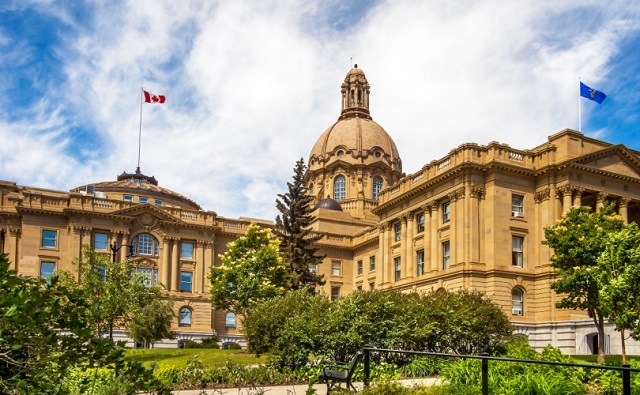Alberta
Federal emissions plan will cost Albertans dearly

A new report finds every Albertan will have $3,300 less for essentials if the ineffective federal emissions reduction plan is left in place.
For years, the federal government has been targeting net zero by 2050 and putting in place an aggressive approach to reduce emissions as outlined in its Emissions Reduction Plan. This scheme, which included the carbon tax, emissions cap, electricity regulations and other initiatives, has drawn strong criticism from provinces, industry, business groups and Canadians.
A report by the Conference Board of Canada, commissioned by Alberta’s government, sheds new light on the negative impacts of the federal government’s punitive environmental approach. By 2050, Alberta’s GDP will shrink by 11 per cent, employment will decline by four per cent and the average person will have $3,300 less in disposable income – while Canada still misses its emissions target.
Alberta’s government is calling on the next federal government to permanently abandon the carbon tax, emissions cap and the entire flawed federal approach. Instead, the federal government should focus on reducing emissions without hurting the economy or making life harder for Albertan and Canadian families.
“These findings should send a message to whoever ends up being the next federal government. Our province remains firmly committed to protecting the environment and creating a future for our children, but that can’t be achieved by trampling on Canadians’ livelihoods. Ottawa has offered nothing but penalties and vague rhetoric. Instead of meaningful incentives to reduce emissions, we get carbon taxes, a production cap, and layers and layers of costly regulations, all burdening families and workers who are already stretched thin.”
The Conference Board of Canada assessed how Alberta businesses and consumers will react to the federal policies based on the costs and effectiveness of the technologies necessary to meet the federal targets.
It found that Alberta will be disproportionately impacted by the current federal plan, experiencing a deep recession in 2030 and subsequently slower economic growth going forward. According to the report, compared to the 2050 baseline scenario, Alberta’s GDP, jobs, revenue and incomes will significantly decline because of federal emissions policies:
- GDP: Projected to be 11 per cent lower
- Employment: Projected to be 4.1 per cent lower
- Government revenues: Projected to be 9.3 per cent lower
- Real (price adjusted) incomes: Down $3,300 (or 7.3 per cent) per person
Nationally, real GDP in Canada is estimated to fall 3.8 per cent in 2050. Canadian oil and gas production in 2050 would be 37 per cent lower, mostly due to the proposed federal oil and gas production cap.
On March 12, the independent Parliamentary Budget Officer (PBO) – following on reports from S&P Global, Deloitte Canada and the Conference Board of Canada – released a scathing report outlining the negative impacts of the proposed federal oil and gas emissions cap. According to the report, the PBO estimates that the federal government’s cap alone will in fact slash oil and gas production by almost 5 per cent, all while these required production cuts reduce nominal GDP by $20.5 billion in 2032.
The PBO report also suggests this policy will reduce economy-wide employment in Canada by 40,300 jobs and full-time equivalents by 54,400 in 2032.
Alberta’s government continues to call for the next federal government to focus on policies that grow the economy, while working with provinces and respecting the Canadian constitution.
Quick facts:
- The Conference Board of Canada scenarios assume oil and gas production grow to 9.7 million barrels of oil equivalent in 2050 with peak oil production of 9.9 million barrels per day in 2042, reflecting continued global oil demand.
- Canada’s employment is estimated to be 2.6 per cent lower, consumer prices 2.5 per cent higher, and real GDP 3.8 per cent lower in 2050 under the federal plan (compared to the baseline scenario).
- According to the report, Canada’s electricity sector would need to reduce emissions by 376 per cent below baseline in 2050, through significant investment in carbon capture and storage, to meet the federal net-zero commitment.
- The Conference Board of Canada’s realistic scenario assumes carbon capture and storage (CCS) will be deployed at a slower rate than is generally assumed by the federal government.
- Canada’s Emission Reduction Plan, released in March 2022, is a roadmap and its policies include the carbon tax, Clean Electricity Regulation, Clean Fuel Regulation, federal oil and gas emissions cap, methane reduction targets, zero emission vehicle mandates, and various other subsidy programs.
- The Conference Board of Canada’s report on assessing the impact of the federal Emissions Reduction Plan was completed prior to U.S. President Donald Trump’s administration and does not include the impacts of potential U.S. tariffs.
- U.S. tariffs have further illustrated the importance of market access to Canada’s energy security.
Related information
Alberta
Red Deer Justice Centre Grand Opening: Building access to justice for Albertans

The new Red Deer Justice Centre will help Albertans resolve their legal matters faster.
Albertans deserve to have access to a fair, accessible and transparent justice system. Modernizing Alberta’s courthouse infrastructure will help make sure Alberta’s justice system runs efficiently and meets the needs of the province’s growing population.
Alberta’s government has invested $191 million to build the new Red Deer Justice Centre, increasing the number of courtrooms from eight to 12, allowing more cases to be heard at one time.
“Modern, accessible courthouses and streamlined services not only strengthen our justice
system – they build safer, stronger communities across the province. Investing in the new Red Deer Justice Centre is vital to helping our justice system operate more efficiently, and will give people in Red Deer and across central Alberta better access to justice.”

Government of Alberta and Judiciary representatives with special guests at the Red Deer Justice Centre plaque unveiling event April 22, 2025.
On March 3, all court services in Red Deer began operating out of the new justice centre. The new justice centre has 12 courtrooms fully built and equipped with video-conference equipment to allow witnesses to attend remotely if they cannot travel, and vulnerable witnesses to testify from outside the courtroom.
The new justice centre also has spaces for people taking alternative approaches to the traditional courtroom trial process, with the three new suites for judicial dispute resolution services, a specific suite for other dispute resolution services, such as family mediation and civil mediation, and a new Indigenous courtroom with dedicated venting for smudging purposes.
“We are very excited about this new courthouse for central Alberta. Investing in the places where people seek justice shows respect for the rights of all Albertans. The Red Deer Justice Centre fills a significant infrastructure need for this rapidly growing part of the province. It is also an important symbol of the rule of law, meaning that none of us are above the law, and there is an independent judiciary to decide disputes. This is essential for a healthy functioning democracy.”
“Public safety and access to justice go hand in hand. With this investment in the new Red Deer Justice Centre, Alberta’s government is ensuring that communities are safer, legal matters are resolved more efficiently and all Albertans get the support they need.”
“This state-of-the-art facility will serve the people of Red Deer and surrounding communities for generations. Our team at Infrastructure is incredibly proud of the work done to plan, design and build this project. I want to thank everyone, at all levels, who helped make this project a reality.”
Budget 2025 is meeting the challenge faced by Alberta with continued investments in education and health, lower taxes for families and a focus on the economy.

Quick facts
- The new Red Deer Justice Centre is 312,000 sq ft (29,000 m2). (The old courthouse is 98,780 sq ft (9,177 m2)).
- The approved project funding for the Red Deer Justice Centre is about $191 million.
Alberta
CPP another example of Albertans’ outsized contribution to Canada

From the Fraser Institute
By Tegan Hill
Amid the economic uncertainty fuelled by Trump’s trade war, its perhaps more important than ever to understand Alberta’s crucial role in the federation and its outsized contribution to programs such as the Canada Pension Plan (CPP).
From 1981 to 2022, Albertan’s net contribution to the CPP—meaning the amount Albertans paid into the program over and above what retirees in Alberta received in CPP payments—was $53.6 billion. In 2022 (the latest year of available data), Albertans’ net contribution to the CPP was $3.0 billion.
During that same period (1981 to 2022), British Columbia was the only other province where residents paid more into the CPP than retirees received in benefits—and Alberta’s contribution was six times greater than B.C.’s contribution. Put differently, residents in seven out of the nine provinces that participate in the CPP (Quebec has its own plan) receive more back in benefits than they contribute to the program.
Albertans pay an outsized contribution to federal and national programs, including the CPP because of the province’s relatively high rates of employment, higher average incomes and younger population (i.e. more workers pay into the CPP and less retirees take from it).
Put simply, Albertan workers have been helping fund the retirement of Canadians from coast to coast for decades, and without Alberta, the CPP would look much different.
How different?
If Alberta withdrew from the CPP and established its own standalone provincial pension plan, Alberta workers would receive the same retirement benefits but at a lower cost (i.e. lower CPP contribution rate deducted from our paycheques) than other Canadians, while the contribution rate—essentially the CPP tax rate—to fund the program would likely need to increase for the rest of the country to maintain the same benefits.
And given current demographic projections, immigration patterns and Alberta’s long history of leading the provinces in economic growth, Albertan workers will likely continue to pay more into the CPP than Albertan retirees get back from it.
Therefore, considering Alberta’s crucial role in national programs, the next federal government—whoever that may be—should undo and prevent policies that negatively impact the province and Albertans ability to contribute to Canada. Think of Bill C-69 (which imposes complex, uncertain and onerous review requirements on major energy projects), Bill C-48 (which bans large oil tankers off B.C.’s northern coast and limits access to Asian markets), an arbitrary cap on oil and gas emissions, numerous other “net-zero” targets, and so on.
Canada faces serious economic challenges, including a trade war with the United States. In times like this, it’s important to remember Alberta’s crucial role in the federation and the outsized contributions of Alberta workers to the wellbeing of Canadians across the country.
-

 2025 Federal Election4 hours ago
2025 Federal Election4 hours agoStudy links B.C.’s drug policies to more overdoses, but researchers urge caution
-

 conflict1 day ago
conflict1 day agoMarco Rubio says US could soon ‘move on’ from Ukraine conflict: ‘This is not our war’
-

 Business20 hours ago
Business20 hours agoChinese firm unveils palm-based biometric ID payments, sparking fresh privacy concerns
-

 2025 Federal Election1 day ago
2025 Federal Election1 day agoPolice Associations Endorse Conservatives. Poilievre Will Shut Down Tent Cities
-

 International2 days ago
International2 days agoNew York Times publishes chilling new justification for assisted suicide
-

 2025 Federal Election2 days ago
2025 Federal Election2 days agoMark Carney Wants You to Forget He Clearly Opposes the Development and Export of Canada’s Natural Resources
-

 2025 Federal Election20 hours ago
2025 Federal Election20 hours agoFormer WEF insider accuses Mark Carney of using fear tactics to usher globalism into Canada
-

 2025 Federal Election1 day ago
2025 Federal Election1 day agoCanada’s press tries to turn the gender debate into a non-issue, pretend it’s not happening





